I recently pitch coached the newest cohort of talented founders at the University of Oxford’s accelerator L.E.V8 at the Oxford Foundry, in preparation for OXFO Demo Day. After my two-day intensive, I was blown away by the transformations that took place and the quality of the final pitches.
To help you understand what a great 3-5 pitch is made of, watch this video of Dr. Alice Curry, CEO of Lantana Publishing. Then read my comments below.
When I’m coaching startups, these are the 10 things I look for in a 3-5 minute investor pitch:
- Are your business and tagline clear?
- What is the problem you’re solving? Is it real and relatable?
- What’s your solution, how is it differentiated from the competition, and how does it work?
- What’s your initial target market? How big is your market? What’s your potential for growth?
- What’s your business model? How do you make money?
- What’s your go-to-market strategy?
- Who’s your competition? Why are you better?
- Why you? Who’s on your team? Did you name and claim your achievements?
- Your Financials: What’s your roadmap going forward? New products, new verticals, new geographies?
- Your Ask: How much do you have to date, how much more do you need, and when do you need it by?
I’m also checking for presentation delivery. If you don’t know how to say it, your message could be lost.
- Does your opening grab our attention?
- Is your delivery style natural and engaging?
- Do your graphics support your pitch?
- Does your closing convince the investors to take the action you want them to take?
Does your opening grab our attention?
The first thing is Alice says is ‘Good evening’. She says her name, and then introduces her nephew Ryan. And then she pauses.
There’s a slight pause between each word—each simple phrase—which allows us to really capture what she’s saying. She’s holding our attention that way.
Your pauses focus the audience’s attention.
She shows an adorable picture of Ryan, and then shares statistics on how common his being multiracial is in the U.K.
“One of three children who identify as black, Asian, or minority ethnic.”
She gives us some basics, something that most people can relate to. It makes us think, okay, yes, I can think of lots of children who are in the same situation as Ryan. This is important.
She clearly presents the problem, and their solution, through Ryan’s story.
What is the problem you’re solving? Is it real and relatable?
“… that’s 1 in 3. Yet, for every 100 books Ryan will read during his childhood, only one will feature a main character who looks like him.”
Only one will give him an identifiable hero, heroine or role model. Instead of 33% of all the books published, representing 1 out of 3 children, only 1% of the books are going to provide an image that reflects back the reality of who he is.(Note: When you work with statistics like these, it’s important to site your source – in a short pitch, you can do so on the slide itself, if not verbally.)
She’s established the problem, it’s real, and it’s relatable.
- She’s got our attention through shocking statistics, that pull on our emotional heartstrings. Everyone knows someone like Ryan. We’re going to care.
- Another thing she does well is that she repeats “only one” for emphasis. This allows us to hang our hearing on the next message she’s going to share.
- The third thing she does well here is that she varies the volume of her voice.
She makes certain words and syllables louder, and then pulls her voice back to make the other ones softer. That’s another way to allow the audience to engage in what you have to say, and hear you better. If she had spoken in a flat monotone the whole time, without any variation in the range and volume of her voice, you would be not interested. You wouldn’t hear. And you wouldn’t remember.
Your key messages, or soundbites, are what you want your audiences to remember. Simplicity and repetition of these key phrases—with the right pauses and variation of volume for effect—will ensure that they do.
What’s your solution, how is it differentiated from the competition, and how does it work?
Her solution is presented as her mission:
“We’re Lantana and we have a mission to see all children included in the stories they read. We work with authors and illustrators of diverse heritage to publish award-winning children’s books where characters of all ethnicities are the stars.”

And then she continues by showing us her product.
She shows us examples of all these beautifully designed children’s books that they’ve published, and she explains exactly who they are addressing. She’s addressing the problem that she’s just described.
“We’ve been praised by the press for celebrating diversity and inclusion in Britain in a fresh creative way.”
It’s not her saying she’s good. It’s the British press that’s saying she’s good. (Note: If the press source is a big one, it’s always a good idea to mention where you’ve received the praise.)
And by sharing what sets them apart from their competition through praise received in the press, she’s clearly stating their differentiators, while in the same breath, she’s building her credibility in the eyes of the investors.
When you’re short on time, you have a lot of important information to fit in—always one of the biggest challenges for my clients. You need to get really creative in how you connect your ideas in a simple narrative that flows.
“And we’ve received just under 20 national and international awards and accolades for our work.”
Normally, in my experience, investors aren’t that interested in your awards. But it doesn’t hurt to put them in, and highlight the name of one impressive award everybody would be able to identify.
What’s your initial target market? How big is your market? What’s your potential for growth?
“We’ve sold 65,000 books to 200 suppliers across 35 countries, with an average year-on-year revenue growth of 168%.”
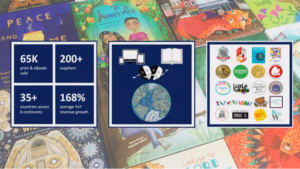
She talks about the number of books they’ve sold, to how many suppliers, in how many countries, and the increase in revenue.
She shows they’re established. They have a market. They’ve already been in business for a year, they have clients who are buying it, and they’re experiencing really fast growth.
She gives statistics and numbers in a clear and simple way.
Investors want the numbers. But they don’t want to be bogged down in the detail.
“We’ve licensed our content to audio and app producers, publishing houses and theatre companies in countries around the world including Korea, India and China…”
Here, she talks about reach: Their geographic reach and also the diversity of the types of verticals and businesses that her books have been sold to, who they’ve appealed to, how large her market is, and potentially how much larger it could be—which is exactly what investors want to hear.
“…reaching around a quarter of a million children each year. And we’ve achieved this with fewer than 20 books. That’s just 2% of the stories submitted to us.”
A quarter of a million children, with fewer than 20 books. So you’re thinking WOW.
There are the statistics again, that show you that there are very few—only 20—books. Yet, she’s reaching 250,000 children. How much could you reach with many more?
She’s already gotten the audience ready to hear her next point.
“Just think how many more children we could reach and how much more quickly we could reach them if we weren’t constrained by the economics of publishing.”
She’s explaining that they’ve created this reach within the existing publishing model from the last 30, 40, 50 years. And then she’s painting a picture in our minds of how quickly, and how many more children they could reach if they left the old publishing model.
What’s your business model? How do you make money?
“Today I’m not pitching you a publishing house. Today I’m pitching you the way we’re transforming diverse publishing into global story sharing.”
She told us what she’s not pitching, which is old-world style publishing. Instead, she’s pitching something new, which she has framed as ‘global story sharing’, and then she’s going to go on to tell us how huge the impact for global story sharing already is in the adult market.
“Lantana’s story is a crowd-sourced, online, story sharing platform that revolutionises the way authors and illustrators generate content. It’s inspired by story sharing platforms like Wattpad, that’s built a community of 70 million readers and generated a series of New York Times bestsellers and a host of new shows for Netflix.
She quotes the Wattpad site that’s already built 70 million adult readers and generated $117M, and has New York Times bestsellers. She’s validating that her model is extremely successful for this new type of story sharing, which she’s going to be applying to children.
“Wattpad is a site for adult writing. Lantana’s stories are the missing link in social storytelling for children. And here’s how it works…”
By saying that they’re ‘the missing link’, she’s implying that there’s nothing else in the market that actually addresses this particular problem in a way that will solve the problem.
“Authors and illustrators submit stories and images to the platform and watch their content grow in popularity as it’s liked and commented on by readers. Parents can sign up to our mailing list, and have free access to 100s if not 1000s of inclusive bedtime stories for their children. We already have 1000 stories. And we already have an engaged and growing community of readers. So now, instead of picking just 2% of those stories to publish, we open them up to our community of readers on the platform and easily identify trending content, so that we can license the IP in the most popular stories to multimedia companies around the world. In effect, we’ve jettisoned the riskiest aspects of publishing in favour of the most lucrative. And we increase the number of children we reach to 7 million.”
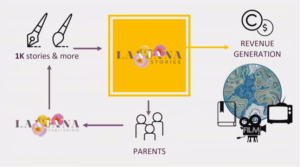
So their model is that it’s free for the B2C market, and the B2B market is where they will be making their money by licensing the most popular stories to media companies, phone companies, etc.
Smart, right?
Why Now? Timing is everything.
“We are living at a great time for children’s content with a global children’s entertainment market worth around $132B.”
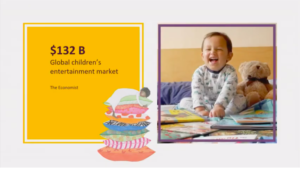
Here, she talks about the relevance of their timing and the massive opportunity it presents. She demonstrates clearly why the timing is NOW.
This is the right time to address this market.
Research shows that a startup’s success depends not only on the their technology, product, service, or team. 40% of their success depends on their timing.
Read more about the correlation between startup success and timing in articles like this one from Entrepreneur: What’s the Secret to Startup Success? Timing.
Why You? Who’s on your team?
“We’re a team of diverse young women, who are passionate about what we do, and who’ve proven we can build a successful, multi award-winning publishing house that’s laid the foundation for a disruptive new model in children’s entertainment.”
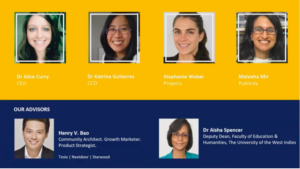
It’s a company run by diverse young women. Their diversity qualifies them for the work they’re doing.
It’s also a good time to be a woman in entrepreneurship.
What’s your Ask? Does your closing convince investors to take the action you want them to take?
Investors want to know how much you need, and how the money will be used.
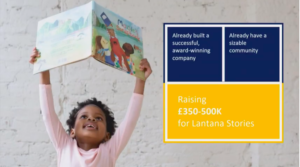
She’s clear that they’re looking to raise 350K – 500K by the end of the year.
Because she only has 4 minutes, she doesn’t give an explanation about what they’re going to do with the money. If she had 5 minutes, she would be able to include this information.
“Last but not least you’ll find one of our books in your goodie bags. Please give this book to a child you know and help become an ambassador for a world where all children feel included.”
At the end, she lets people know that they’ll receive one of her products, a book, in their goody bags. This is one of the best things you can do. It’s like having a demo. There are 10 companies pitching, but after her pitch, everybody is going to have one of her products.
Finally, she invites everyone to be ambassadors for her brand and to do something great for children in the world. It’s a very inspirational and extremely effective closing.
Is your delivery style natural and engaging?
Alice did a great job. Here’s what stood out for me in her delivery:
- She’s very engaging and conversational, in an aspirational way.
- She’s expansive in terms of her energy and how she delivers.
- She’s very very good with her eye contact.
- Her hand gestures are perfect for how she’s holding and moving her body.
- She’s very natural and authentic.
- She looks comfortable and confident.
Do your graphics support your pitch?

I loved the way the graphics from her books are integrated in her presentation, giving a feel for the products.
All the cartoons of the children are outstanding and always different.
I later heard from Dr. Curry that 4 or 5 investors approached her immediately after her pitch. So, something here was clearly working. I wish Lantana all the best—they deserve it!
Do you have a video of a pitch you’ve done that you want submit for comment on our blog? Send it to: pitch@bethsusanne.com and we’ll review it for consideration.




